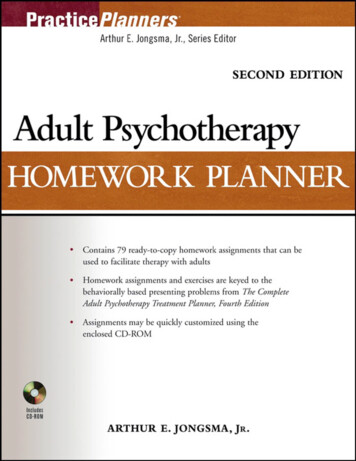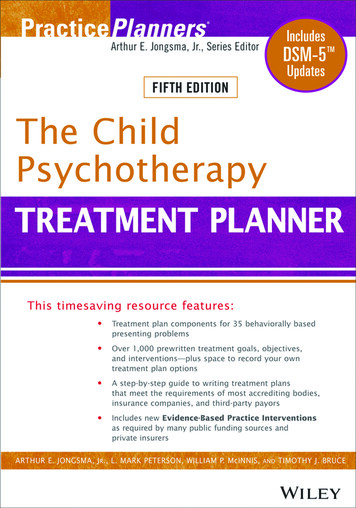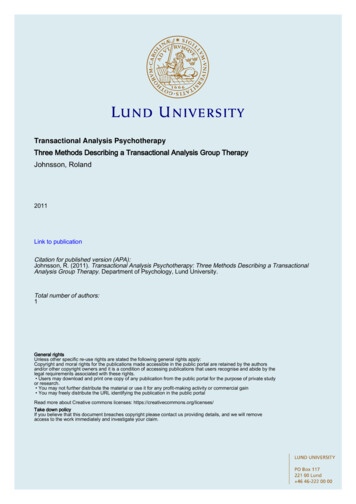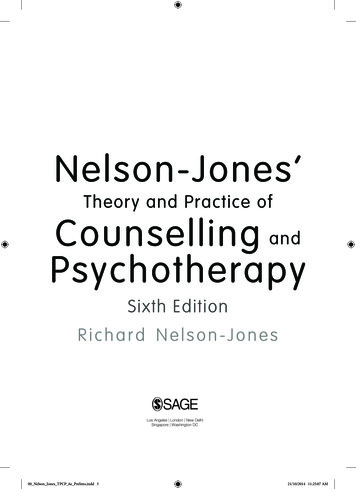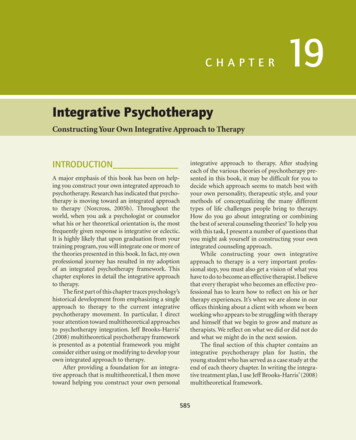
Transcription
CHAPTER19Integrative PsychotherapyConstructing Your Own Integrative Approach to TherapyINTRODUCTIONA major emphasis of this book has been on helping you construct your own integrated approach topsychotherapy. Research has indicated that psychotherapy is moving toward an integrated approachto therapy (Norcross, 2005b). Throughout theworld, when you ask a psychologist or counselorwhat his or her theoretical orientation is, the mostfrequently given response is integrative or eclectic.It is highly likely that upon graduation from yourtraining program, you will integrate one or more ofthe theories presented in this book. In fact, my ownprofessional journey has resulted in my adoptionof an integrated psychotherapy framework. Thischapter explores in detail the integrative approachto therapy.The first part of this chapter traces psychology’shistorical development from emphasizing a singleapproach to therapy to the current integrativepsychotherapy movement. In particular, I directyour attention toward multitheoretical approachesto psychotherapy integration. Jeff Brooks-Harris’(2008) multitheoretical psychotherapy frameworkis presented as a potential framework you mightconsider either using or modifying to develop yourown integrated approach to therapy.After providing a foundation for an integrative approach that is multitheoretical, I then movetoward helping you construct your own personalintegrative approach to therapy. After studyingeach of the various theories of psychotherapy presented in this book, it may be difficult for you todecide which approach seems to match best withyour own personality, therapeutic style, and yourmethods of conceptualizing the many differenttypes of life challenges people bring to therapy.How do you go about integrating or combiningthe best of several counseling theories? To help youwith this task, I present a number of questions thatyou might ask yourself in constructing your ownintegrated counseling approach.While constructing your own integrativeapproach to therapy is a very important professional step, you must also get a vision of what youhave to do to become an effective therapist. I believethat every therapist who becomes an effective professional has to learn how to reflect on his or hertherapy experiences. It’s when we are alone in ouroffices thinking about a client with whom we beenworking who appears to be struggling with therapyand himself that we begin to grow and mature astherapists. We reflect on what we did or did not doand what we might do in the next session.The final section of this chapter contains anintegrative psychotherapy plan for Justin, theyoung student who has served as a case study at theend of each theory chapter. In writing the integrative treatment plan, I use Jeff Brooks-Harris’ (2008)multitheoretical framework.585
Brief Historical Overview of theIntegrative MovementThe movement toward integration of the variousschools of psychotherapy has been in the makingfor decades. On the whole, however, psychotherapyintegration has been traditionally hampered byrivalry and competition among the various schools.Such rivalry can be traced to as far back as Freudand the differences that arose between him and hisdisciples over what was the appropriate frameworkfor conceptualizing clients’ problems. From Freud’sWednesday evening meetings on psychoanalysis, anumber of theories were created, including Adler’sindividual psychology. As each therapist claimedthat he had found the one best treatment approach,heated battles arose between various therapy systems. When behaviorism was introduced to thefield, clashes took place between psychoanalystsand behaviorists.During the 1940s, 1950s, and 1960s, therapists tended to operate within primarily onetheoretical school. Dollard and Miller’s (1950)book, Personality and Therapy, was one of thefirst attempts to combine learning theory withpsychoanalysis. In 1977, Paul Wachtel publishedPsychoanalysis and Behavior Therapy: Toward anIntegration. In 1979, James Prochaska offered atranstheoretical approach to psychotherapy, whichwas the first attempt to create a broad theoreticalframework.In 1979, Marvin Goldfried, Paul Wachtel, andHans Strupp (Strupp & Binder, 1984) organizedan association, the Society for the Explorationof Psychotherapy Integration (SEPI), for clinicians and academicians interested in integrationin psychotherapy (Goldfried, Pachankis, & Bell,2005). Shortly thereafter in 1982, The InternationalJournal of Eclectic Psychotherapy was published,and it later changed its name to the Journal ofIntegrative and Eclectic Psychotherapy. By 1991,it began publishing the Journal of PsychotherapyIntegration. As the field of psychotherapy hasdeveloped over the past several decades, there hasbeen a decline in the ideological cold war among586the various schools of psychotherapy (Goldfried,Pachankis, & Bell, 2005).Norcross and Newman (1992) have summarized the integrative movement in psychology byidentifying eight different variables that promotedthe growth of the psychotherapy integration trendin counseling and psychotherapy. First, they pointout that there was simply a proliferation of separatecounseling theories and approaches. The integrative psychotherapy movement represented a shiftaway from what was the prevailing atmosphereof factionalism and competition amongst thepsychotherapies and a step toward dialogue andcooperation. Second, they note that practitionersincreasingly recognized the inadequacy of a singletheory that is responsive to all clients and theirvarying problems. No single therapy or group oftherapies had demonstrated remarkable superiorefficacy in comparison to any other theory. Third,there was the correlated lack of success of any onetheory to explain adequately and predict pathology,personality, or behavioral change.Fourth, the growth in number and importance of shorter-term, focused psychotherapieswas another factor spearheading the integrativepsychotherapy movement. Fifth, both cliniciansand academicians began to engage in greater communication with each other that had the net effectof increasing their willingness to conduct collaborative experiments (Norcross & Newman, 1992).Sixth, clinicians had to come to terms with theintrusion into therapy with the realities of limitedsocioeconomic support by third parties for traditional, long-term psychotherapies. Increasingly,there was a demand for therapist accountabilityand documentation of the effectiveness of all medical and psychological therapies. Hence, the integration trend in psychotherapy has also been fueled byexternal realities, such as insurance reimbursementand the popularity of short-term, prescriptive, andproblem-focused therapists.Seventh, researchers’ identification of common factors related to successful therapy outcomeinfluenced clinicians’ tendency toward psychotherapy integration. Increasingly, therapists beganPA R T I V TH E F O U R T H F ORCE I N PS YCHOTHER A PY
to recognize there were common factors that cutacross the various therapeutic schools. Eighth, thedevelopment of professional organizations such asSEPI, professional network developments, conferences, and journals dedicated to the discussion andstudy of psychotherapy integration also contributed to the growth of the movement. The helpingprofession has definitely moved in the direction oftheoretical integration rather than allegiance to asingle therapeutic approach. There has been a concerted movement toward integration of the varioustheories (Prochaska & Norcross, 2010).Definition of IntegrativePsychotherapyAs noted in Chapter 1, integrative psychotherapyis an attempt to combine concepts and counseling interventions from more than one theoreticalpsychotherapy approach (Stricker, 2001). It is not aparticular combination of counseling theories, butrather it consists of a framework for developing anintegration of theories that you find most appealing and useful for working with clients. Accordingto Norcross (2005b):Psychotherapy integration is characterized bydissatisfaction with single-school approaches and aconcomitant desire to look across school boundariesto see what can be learned from other ways ofconducting psychotherapy. The ultimate outcomeof doing so is to enhance the efficacy, efficiency, andapplicability of psychotherapy. (pp. 3–4)PATHWAYS TO PSYCHOTHERAPYINTEGRATIONThis section provides an overview of how theorists and practitioners have tried to integrate thevarious theoretical approaches to therapy. Perhapsin examining how others have integrated theirtherapy with different concepts and techniques,you might feel more comfortable in thinkingabout how you might pursue this same avenue.Clinicians have used a number of ways to integratethe various counseling theories or psychotherapy,including technical eclecticism, theoretical integration, assimilative integration, common factors,multitheoretical psychotherapy, and helping skillsintegration (Norcross & Goldfried, 2005).Definition of EclecticismEclecticism may be defined as an approach to thoughtthat does not hold rigidly to any single paradigm orany single set of assumptions, but rather draws uponmultiple theories togain insight into pheInner Reflectionsnomena. Eclectics aresometimes criticizedKey Points in thefor lack of consistencyIntegrative Movementin their thinking. ForWhat key developmentsinstance, many psystand out in yourchologistsacceptmind about thesome features ofintegrative movement inbehaviorism, yet theypsychotherapy?do not attempt to usethe theory to explainThoughts about theoryall aspects of clientintegration date back tobehavior. Eclecticismthe 1930s and 1940s. Inin psychology hasyour opinion, what took sobeen caused by thelong for the movement tobelief that many facreach its current status?tors influence humanbehavior; therefore, itis important to examine a client from a number oftheoretical perspectives (Goldfried, Pachankis, &Bell, 2005).What are some differences between eclecticism and psychotherapy integration? Typically,eclectic therapists do not need or have a theoretical basis for either understanding or using aspecific technique. They chose a counseling technique because of its efficacy, because it works. Forinstance, an eclectic therapist might experience apositive change in a client after using a specifiedcounseling technique, yet not investigate any further why the positive change occurred. In contrast,an integrative therapist would investigate the howand why of client change. Did the client changeCHAPT ER 19 I NTEG R ATI VE PS YCHOTHER A PY587
because she was trying to please the therapist orwas she instead becoming more self-directed andempowered?Integrative and eclectic therapists also differ inthe extent to which they adhere to a set of guiding,theoretical principles and view therapy change.Practitioners who call themselves eclectic appearto have little in common, and they do not seem tosubscribe to any common set of principles. In contrast, integrationists are concerned not only withwhat works but why it works. Moreover, clinicianswho say they are eclectic tend to be older and moreexperienced than those who describe themselves asintegrationists. This difference is fast disappearingbecause some graduate schools are beginning totrain psychologists to be integrationists (Norcross& Goldfried, 2005). It is noteworthy, however, thatpractitioners ascribe to eclecticism/integration morefrequently than academic and training faculty do(Norcross & Goldfried, 2005). Hence, it may takea while for therapist training programs to movetoward integration of theory.Theoretical IntegrationTheoretical integration is perhaps the most difficult and sophisticated of the three types ofpsychotherapy integration because it involvesbringing together theoretical concepts from disparate theoretical approaches, some of which maypresent contrasting worldviews. The goal is tointegrate not just therapy techniques but also thepsychotherapeutic theories involved as Dollardand Miller (1950) did with psychoanalysis andbehavior therapy. Proponents of theoretical integration maintain that it offers new perspectives atthe levels of theory and practice because it entailsa synthesis of different models of personalityfunctioning, psychopathology, and psychologicalchange.Assimilative IntegrationThe assimilative integration approach to psychotherapy involves grounding oneself in one system588of psychotherapy but with a view toward selectivelyincorporating (assimilating) practices and viewsfrom other systems. Assimilative integrationists usea single, coherent theoretical system as its core, butthey borrow from a broad range of technical interventions from multiple systems. Practitioners whohave labeled themselves as assimilative integrationists are: (1) Gold (1996), who proposed assimilative psychodynamic therapy; (2) Castonguay et al.(2004), who have advocated cognitive-behavioralassimilative therapy; and (3) Safran, who hasproposed interpersonal and cognitive assimilativetherapy (Safran & Segal, 1990/1996).Assimilative integrationists believe integrationshould take place at the practice level rather than atthe theory level. Most therapists have been trainedin a single theoretical approach, and over time manygradually incorporate techniques and methodsof other approaches (Goldfried, 2001; Dryden &Spurling, 1989). Typically, therapists do not totallyeliminate the theoretical framework in which theywere trained. Instead, they tend to add techniquesand different ways of viewing individuals.The Common Factor ApproachThe common factors approach has been influencedby the research and scholarships of such renownedleaders in psychotherapy as Jerome Frank (1973,1974) and Carl Rogers (1951, 1957). Clearly,Rogers’ contributions to common factors researchhas become so accepted by clinicians throughoutthe world that his core conditions (or necessaryand sufficient conditions to effect change in clients)have become part of the early training of mosthelping professionals (Rogers, 1951). Researchersand theorists have transformed Rogers’ necessaryand sufficient conditions into a broader conceptthat has become known as “therapeutic alliance”(Hubble, Duncan, & Miller, 1999). The therapeuticalliance is important across the various counselingtheory schools; it is the glue that keeps the personcoming to therapy week after week. Currently,more than 1,000 studies have been reported on thetherapeutic alliance (Hubble, Duncan, & Miller,PA R T I V TH E F O U R T H F ORCE I N PS YCHOTHER A PY
1999). In describing the common factor approach,Norcross (2005b, p. 9) has stated:The common factors approach seeks to determinethe core ingredients that different therapies share incommon, with the eventual goal of creating moreparsimonious and efficacious treatments based ontheir commonalities. This search is predicated onthe belief that commonalities are more importantin accounting for therapy outcome than the uniquefactors that differentiate among them.MULTITHEORETICALAPPROACHESRecently, therapists have developed multitheoreticalapproaches to therapy. Multitheoretical frameworksdo not attempt to synthesize two or more theoriesat the theoretical level. Instead, there is an effortto “bring some order to the chaotic diversity inthe field of psychotherapy and “preserve the valuable insights of major systems of psychotherapy”(Prochaska & DiClemente, 2005, p. 148). The goal ofmultitheoretical approaches is to provide a frameworkthat one can use for using two or more theories. Twoexamples of multitheoretical frameworks are (1)the transtheoretical approach by Prochaska andDiClemente (1984, 2005), and (2) multitheoreticaltherapy by Brooks-Harris (2008).The Transtheoretical ModelThe most widely recognized model using a multitheoretical framework has been the transtheoretical model developed by Prochaska and DiClemente(1984, 2005). The transtheoretical model is a modelof behavioral change, which has been the basisfor developing effective interventions to promotehealthy behavior change. Key constructs are integrated from other counseling theories. The modeldescribes how clients modify a problem behavioror how they develop a positive behavior. The central organizing construct of the model is the stagesof change. The theorists maintain that change takesplace through five basic stages: (1) precontemplation,(2) contemplation, (3) preparation, (4) action, and(5) maintenance.In the precontemplation stage, people are notintending to take action in the foreseeable future,usually measured as the next 6 months. Duringthe contemplation stage, people are intending tochange within the next 6 months. In the preparation stage, clients are intending to take action inthe immediate future, usually measured as the nextmonth. Clients in the action stage have made specific overt modifications in their life styles withinthe past 6 months. During the maintenance stage,clients work to prevent relapse, a stage which isestimated to last from 6 months to about 5 years.The termination stage of change contains clientswho have zero temptation and 100% self-efficacy.They are confident they will not return to their oldunhealthy habit as a way of coping.The transtheoretical model also proposes 10processes of change, which are the covert and overtactivities that people use to progress through thestages. The first 5 processes involve experientialprocesses of change, while the last 5 are labeledbehavioral processes, and these are used primarily for later-stage transitions. For instance, during the experiential processes of change, peopleexperience consciousness raising (“I rememberinformation people gave me about how to stopsmoking”) and social liberation (“I find societychanging in ways that make it easier for me tobe a nonsmoker”). The 5 behavioral processesof change range from (6) stimulus control to (8)counterconditioning (“I do other things with myhands to stop smoking”) to (10) self-liberation (“Imake commitments not to smoke”).The transtheoretical model does not makeassumptions about how ready clients are for changein their lives. The model proposes that differentindividuals will be in different stages and thatappropriate interventions must be developed forclients based on their stages of development. Thetranstheoretical model assumes that the differentsystems of psychotherapy are complementary andthat different theories emphasize different stagesand levels of change.CHAPT ER 19 I NTEG R ATI VE PS YCHOTHER A PY589
Brooks-Harris’ MultitheoreticalModelThe most recent multitheoretical model forpsychotherapy comes from Brooks-Harris, whoprovides a framework that describes how different psychotherapy systems come together.Brooks-Harris (2008) begins with the premise thatthoughts, actions, and feelings interact with oneanother and that they are influenced by biological, interpersonal, systemic, and cultural contexts.Given this overarching premise, he integrates thefollowing theoretical approaches: (1) cognitive, (2)behavioral, (3) experiential, (4) biopsychosocial,(5) psychodynamic, (6) systemic, and (7) multicultural. A brief explanation of each of these areas isprovided below. His framework emphasizes at whatpoint a therapist might consider using elementsof psychodynamic theory or multicultural theory.A major umbrella in multicultural psychotherapyconsists of the focal dimensions for therapy andkey strategies.MULTITHEORETICAL PSYCHOTHERAPY Cognitive strategies deal with the focal dimension of clients’ functional and dysfunctional thoughts.Behavioral skills–focal dimension of actions encourage effective client actions to deal with challenges.Experiential interventions result in adaptive feelings.Biopsychosocial strategies emphasize biology and adaptive health practices.Psychodynamic-interpersonal skills are used to explore clients’ interpersonal patterns and promote undistortedperceptions. Systemic-constructivist interventions examine the impact of social systems and support adaptive personal narratives. Multicultural-feminist strategies explore the cultural contexts of clients’ issues.Brooks-Harris (2008) presents five principlesfor psychotherapy integration, which include (1)intentional integration, (2) multidimensionalintegration, (3) multitheoretical integration, (4)strategy-based integration, and (5) relational integration. The first principle says that psychotherapyintegration should be based on intentional choices.The therapist’s intentionality guides his or herfocus, conceptualization, and intervention strategies. Principle two (multidimensional) proposesthat therapists should recognize the rich interaction between multiple dimensions.The third principle asserts that therapists takeinto consideration diverse theories to understandtheir clients and guide their interventions. The fourthstrategy-based principle states that therapists combine specific strategies from different theories.590Strategy-based integration uses a pragmatic philosophy. Underlying theories do not have to bereconciled. The fifth or relational principle proposesthat the first four principles must be enacted withinan effective therapeutic relationship.Brooks-Harris’ (2008) model offers a goodplan for therapists seeking to implement an integrative multitheoretical approach. He outlinesstrategies for each of the seven core areas. Forinstance, cognitive strategies should encouragefunctional thoughts that are rational and that promote healthy adaptation to the environment. Inaddition, he enumerates a catalog of 15 key cognitive strategies, which include identifying thoughts,clarifying the impact of thoughts, challenging irrational thoughts, providing psychoeducation, andsupporting bibliotherapy. To integrate behavioralPA R T I V TH E F O U R T H F ORCE I N PS YCHOTHER A PY
Inner ReflectionsPathways toPsychotherapy IntegrationWhich pathwayto psychotherapyintegration do youchoose—eclecticism,assimilative integration,theoretical integration,multitheoreticalframework?therapy into one’spractice, he suggestssome of the following catalog of keystrategies: assigninghomework,constructing a hierarchy,providing trainingand rehearsal, determining baselines,and schedules ofreinforcement.Integrative treatment planning. Themultitheoretical psycho therapy (MTP) modeloffers a step-by-stepmethod to engage inintegrative treat ment planning. The first three steps emphasize usingthe multidimensional manner and the therapist’s need tomake intentional choices about the use of multitheoreticalstrategies. The last two steps emphasize using the catalogof key strategies during the psychotherapy process. Stepone involves watching for multidimensional focus markers. As clients tell their stores and describe their concerns,therapists listen for markers that reveal clients’ areas ofconcerns. The therapist uses the Focus Marker Checklist,which is available on the web in the treatment resourcessection of http://www.multitheoretical.com.Step two involves conducting a multidimensional survey to explore the seven dimensions ina structured manner: (1) thoughts, (2) actions,(3) feelings, (4) biology, (5) interpersonal patterns, (6) social systems, and (7) cultural contexts.Brooks-Harris (2008) suggests that the therapistconduct a multidimensional survey (examine theseven areas to determine which area is of mostconcern to the client). Step three emphasizesestablishing an interactive focus on two or threedimensions. After the therapist surveys the client’s problems in terms of all seven dimensions,the therapist and client collaboratively identifytwo or three salient dimensions that will formDo you have any particularreasons for choosing yourdesignated pathway topsychotherapy integration?the initial focus of therapy. Step four entails formulating a multitheoretical conceptualization ofthe client’s problem. A summary of multitheoretical conceptualization is provided on the webin the treatment resources section of http://www.multitheoretical.com. Step five involves choosing interventions from a catalog of key strategiesfor each of the seven areas of client functioning.A summary of the catalog of key strategies is alsofound on the theory’s website.The multitheoretical model of psychotherapygives the example of Claire, a Japanese-Americanfemale in her 50s who is experiencing symptomsof depression after the death of her mother, alittle over a year ago. The client is the oldest ofthree daughters; she has never married, lived withher mother, and was the primary caretaker whileher mother was dying. Claire’s multidimensionalsurvey will examine the seven core areas BrooksHarris outlines. Claire’s:Thoughts: “I am having difficulty going on withoutmy mother.”Actions: Withdrawal and social isolation fromfamily and friendsFeelings: Despair, hopelessness, numbing sense ofbeingBiology: Decreased appetite and trouble sleepingInterpersonal: Claire’s focus on being her mother’sfavorite childSocial: Claire competed with her sisters growing up.Her father was emotionally distant.Cultural: In the Japanese-American tradition, theeldest takes care of her parents.After surveying all seven dimensions of themultitheoretical model, the therapist selects twoor three that will function as the initial focus forpsychotherapy. He or she consults with Claireto determine the two dimensions on which shewould like to work. Claire chooses her feelings ofhopelessness and despair and her interpersonalpatterns—the fact that her close relationship withCHAPT ER 19 I NTEG R ATI VE PS YCHOTHER A PY591
her mother got in the way of her developing othersources of social support. For each focal dimension,the therapist chooses an existing theoretical school.For instance, to deal with the feeling conceptualization of Claire’s issue, the therapist selects emotionfocused therapy. The therapeutic goal is to helpClaire explore and express her sadness in moreadaptive ways. To deal with her core conflictualrelationship theme, the therapist uses psychodynamic conceptualizations. The therapist identifiesrelationship themes with Claire by exploring childhood experiences and her adaptations to interpersonal losses. The therapist uses the Key Strategiesinformation provided on the website http://www.multitheoretical.com.Evidence-Based Therapy andIntegrative PracticeRegardless of whether a therapist uses an integrativeapproach or one based on a single therapy school, heor she will have to take into consideration whether ornot empirical support exists for a chosen treatmentapproach (American Psychological Association,2006). Evidence-based practice (EBP) is a combination of learning what treatments work based onthe best available research and taking into accountclients’ culture and treatment issues. The AmericanPsychological Association (2006, p. 273) conceptualizes evidence-based practice as “the integration ofthe best available research with clinical expertise inthe context of patient characteristics, culture andpreferences.” Evidence-based practice emphasizesthe results of experimental comparisons to document the efficacy of treatments against untreatedcontrol groups, against other treatments, or both.The arguments in favor of EBP are reasonable.First, clients have a right to treatments that have beenproven to be effective (Gibbs, 2003). Second, managedcare requires counselor accountability in choosinga method of treatment. Increasingly, counselorsmay have to consult with research studies to determine which approach is the most efficacious withwhat mental health disorder (Gibbs, 2003). Helping592professionals may beInner Reflectionsrequired to answerfor using a therapeuTheories You Want totic approach with aIntegratespecific disorder.Have you given anyTwenty years ago,thought to the counselingfew therapists wouldtheories you might want tohave been concernedintegrate in your approachabout whether orto therapy?not their theoretical approach hadIs there any particularaccumulated muchschool of therapy—research evidence topsychodynamic,support treatment ofexistential-humanistic,a particular disorder.cognitive-behavioral, orHowever, conditionsconstructivist—that youhave changed in thefeel resonates with you?world of therapy.Therapists must nowbe able to not only articulate a psychotherapeuticorientation, but ethical issues are now also beingraised about one’s choice of orientation for specificmental disorders.Evidence-based treatment presents several ethical issues to clinicians. First, do you know whatevidence exists to support your psychotherapeutictreatment of clients? What research evidence existsto demonstrate that your theoretical perspectiveand interventions actually do work and help clientsrecover from their disorders? Are you familiar withthe treatments that have been found to be empirically supported in the psychotherapeutic literature?Or, do you use the same theoretical approach,regardless of the client’s presenting problem ordisorder? How ethical is it for you to use your theoretical approach when one examines it in terms ofits treatment efficacy?How does a therapist implement EBP in practice? The therapist must gather research that informshim or her about what works in psychotherapy.Such information should be obtained before treatment is begun. There are several major resources forevidence-based practice. For instance, the CochraneCollaboration (http://www.cochrane.org) setsPA R T I V TH E F O U R T H F ORCE I N PS YCHOTHER A PY
standards for reviews of medical, health, and mentalhealth treatments and provides “systematic reviews”of related research by disorder. The CochraneCollaboration is an international, independent,not-for-profit organization of over 28,000 contributors from more than 100 countries, dedicated tomaking up-to-date, accurate information about theeffects of health care readily available worldwide.The Cochrane Reviews contain systematic healthcare interventions that are published online in TheCochrane Library. Cochrane Reviews are designedto help providers, practitioners, and patients makeinformed dec
Integrative and Eclectic Psychotherapy. By 1991, it began publishing the Journal of Psychotherapy Integration. As the field of psychotherapy has developed over the past several decades, there has been a decline in the ideological cold war among the various schools of psychot
